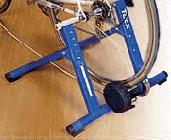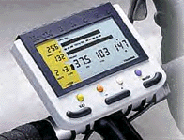Turbo training can be very anti-social, as even the best of cycle trainers available are noisy.
 A garage or garden shed away from the house is often the best place to set up your turbo. Assemble the turbo according to the manufacturer's instruction and fit the bike with the rear tyre just touching the turbo roller. You need enough contact to create resistance, but bear in mind that when you are mounted on the bike the contact will be greater. Make sure that the whole unit is level and that you have taken every possible precaution to reduce vibrations.
A garage or garden shed away from the house is often the best place to set up your turbo. Assemble the turbo according to the manufacturer's instruction and fit the bike with the rear tyre just touching the turbo roller. You need enough contact to create resistance, but bear in mind that when you are mounted on the bike the contact will be greater. Make sure that the whole unit is level and that you have taken every possible precaution to reduce vibrations.
Place the clock and electric fan somewhere in front of you. Give the turbo and bike frame a good waxing/polishing to help protect them against sweat damage. If sweat does drip on your bike you should wash the bike at regular intervals. If you have to use your racing bike, you need to take added precautions against sweat damage by draping a large towel over the bars, stem and top tube of the bike.
Clothing
The clothing that you would normally wear for a serious training session is what you should wear for turbo training. Racing shorts or tights with racing jersey and/or under vest should be the basic kit. You will soon warm up and sweat far more than usual since there is no cooling breeze, hence the suggestion of the fan. The electric fan will help to cool you off a little, but as your effort increases, you will notice that sweat is dripping off your face onto the bike, which in time, if not prevented, will cause damage.
Using your turbo
In your first session, get the feel of the turbo. If you intend to use aero bars in racing, then it is worthwhile using them in your turbo sessions. Conditioning your body for intensive efforts in the racing position is all part of the attention to detail that will help you towards improved performances.
Concentrate on good pedalling style and keep your revolutions smooth. Unless your turbo is fitted with a flywheel your early efforts will be jerky, but as you concentrate on the smooth pedalling action you will soon develop a smooth technique.
Change gear (or adjust the resistance) and ride at various degrees of effort and pedal revolutions. If you have a heart monitor use it to get an idea of your response to the levels of exertion. For a wide selection of the best heart rate monitors from POLAR, click the name. If not, start learning to always count your pedal revs. Remember, it is the full revolution that you count.
Keep your early sessions short, ten to fifteen minutes at the most or you may be disappointed and want to throw your turbo in the nearest river. Don't do that, with the correct use it will become a major training ally!
 Planning your turbo training programme
Planning your turbo training programme
As with all training, turbo efforts should be planned, progressive efforts. Give some thought to your cycling/racing goals, and plan a programme of interval sessions on the turbo to help you to achieve them.
There are many variations to interval training and the best idea is to experiment with several different sessions to find a programme that is both progressive and right for you. Intervals can vary from seconds of effort to several minutes of effort, and the recovery time equally varied.
We give various examples of turbo sessions elsewhere in this section but a typical progressive programme can be as follows:
Week one Warm up, then change to 52 x 16 and pedal hard for one minute with pedal revs at about 100 rpm and raising your heart rate to high-level 3/low-level 4. On completion change down to about 42 x 16 and pedal at about 60 rpm to allow recovery for one minute. Repeat 5 times. Warm down.
Week two Warm up, and then complete 7 intervals.
Week three Warm up, and then complete 10 intervals.
Week four Warm up, and then carry out the session you performed during week one but this time only allow your pulse rate to rise into level 2. This week is effectively a "recovery", or rest week, that allows your system to recover fully from the efforts that you have been making on your turbo.
Week five Warm up, and then complete 10 intervals.
Week six Warm up, and then complete 12 intervals.
Week seven Warm up, and then complete 15 intervals.
Week eight Warm up, and then carry out the session you performed during week one, again only allowing your pulse rate to rise into level 2. This week again is a rest or "active recovery" week allowing your system to recover fully from the efforts that you have made on your turbo.
The above sessions can easily be altered to suit your own standard of fitness and racing needs and are designed primarily to show the progressive nature of effective training programmes.
For a selection of Turbo trainers click the link.